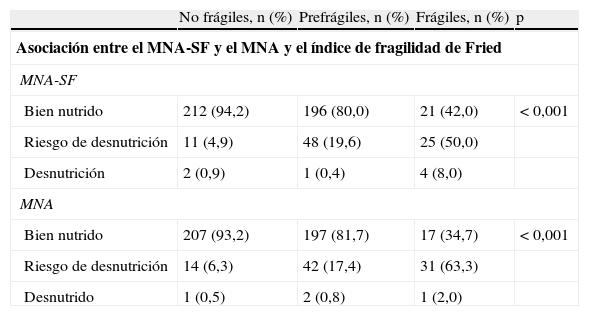Valorar la asociación entre el Mini Nutritional Assessment (MNA) y el índice de fragilidad de Fried en las personas mayores que viven en la comunidad.
Material y métodoEstudio transversal en individuos de 75 años o más, residentes en la comunidad. Como variables se incluyeron el estado nutricional medido a través del MNA y su forma abreviada, el Mini Nutritional Assessment Short Form (MNA-SF), y el índice de fragilidad a través de los criterios de Fried.
ResultadosLa muestra fue de 640 individuos, con media (DE) de edad de 81,3 (5,0) años; el 39,7% eran varones. Según el MNA-SF, el 76,9% de los individuos estaban bien nutridos, el 19,8% en riesgo de desnutrición y el 1,9% desnutridos, mientras que según el MNA, dichos porcentajes fueron del 78,1, 19,6 y 2,3%, respectivamente. Según los criterios de Fried, el 43,4% eran no frágiles, el 47%, prefrágiles, y el 9,6%, frágiles. La mayor proporción de sujetos frágiles se encontraban en riesgo de desnutrición. La puntuación del MNA y del MNA-SF en los sujetos frágiles fue significativamente menor que en los prefrágiles y no frágiles. A medida que aumentaba la puntuación de los componentes del MNA, aumentaba el índice de fragilidad. Así mismo, existía una asociación significativa entre los 5 criterios de fragilidad y las categorías del MNA y el MNA-SF. El área bajo la curva ROC para el MNA-SF fue de 0,75, mientras que para el MNA fue de 0,80.
ConclusionesLos resultados presentados ponen de manifiesto la clara asociación entre el MNA y los criterios de Fried. También evidencian que la categoría del MNA «riesgo de desnutrición» es la que está más fuertemente asociada al índice de fragilidad.
To assess the association between Mini Nutritional Assessment (MNA) and the Fried frailty index in older people living in the community.
Material and methodCross-sectional study of individuals aged 75 and over living in the community. Variables: nutritional status measured by Mini Nutritional Assessment Short Form (MNA-SF) and MNA, and frailty measured by Fried's frailty criteria.
ResultsThe sample consisted of 640 individuals with a mean age of 81.3±5.0 years; 39.7% were men. According to the MNA-SF, 76.9% of patients were well nourished, 19.8% were at risk of malnutrition and 1.9% were malnourished, while percentages were 78.1, 19.6 and 2.3%, respectively, according to the MNA. According to Fried criteria, 43.4% were not frail, 47% were pre-frail and 9.6% were frail. The largest proportion of frail subjects were at risk of malnutrition. The higher the score of MNA components, the higher was the frailty index. Likewise, there was a significant association between the 5 frailty criteria and the categories of MNA and MNA-SF. The area under the ROC curve for the MNA-SF was 0.75 while for the MNA it was 0.80.
ConclusionsThe results presented show a clear association between Mini Nutritional Assessment and Fried's criteria. They also suggest that the «nutritional risk» MNA category is the one most strongly associated with the Fried's frailty index.
Artículo
Comprando el artículo el PDF del mismo podrá ser descargado
Precio 19,34 €
Comprar ahora










